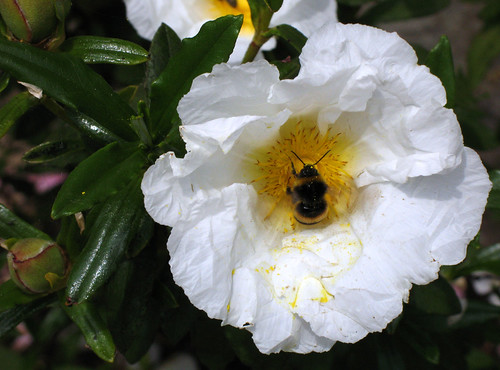I am currently reading What on Earth Happened?… In Brief (the planet life and people from the big bang to the present day). It is full of interesting facts and today I learned some interesting facts about bees, I had no idea there were so many different species of bee.
Bees descended from wasps and emerged alongside the first flowers. They switched from dining on other insects to a diet of pollen and nectar instead. There are 20,000 different species of bee alive today. Some of these – especially honeybees, bumblebees and stingless bees – form highly social groups that offer a deep insight into how nature’s civilizations work.
Eusocial creatures divide up jobs between themselves. They pass knowledge and learning on form one generation to another, care for their youngsters and even, in certain circumstances, sacrifice lives for the benefit of the group. Such characteristics were for a long time thought to be unique to mankind when it first organized itself into tribes and eventually cities and states. But, as any beekeeper will tell you that is not so.
Katherine Swift who wrote The Morville Hours is a beekeeper and there were many interesting snippets about bees in her book too. One of the things she mentions is that bees are now threatened by Varroa which is a parasitic mite endemic in most countries. It arrived in the UK in the mid 1990s. The mites attach themselves to the bees and weaken their bodies. This is easy to treat in domesticated bees, but not in wild bees which if left untreated can lead to the extinction of whole colonies.
I say long live the bee.









Sounds interesting. I can spend hours watching bees doing what they do best. We had a wild honey bee nest but only for one summer and leafcutter bees nesting from time to time
I love bees, but am not so fond of wasps they keep landing on my sting first… So I was quite amazed to learn that bees descended from wasps!
Sounds interesting. I had no idea there were so many types of bee or that they came from wasps.
Me neither, both were a surprise!
Cherie – this is fascinating. I didn’t know about bees’ waspish ancestry either. But I did know about the parasitic mite threatening the survival of wild bees in eg the West Country/Forest of Dean – and is also wreaking havoc in southern France. Bees are wonderful creatures; like Jams, I love watching them. And thank you for yet another valuable book recommendation that otherwise I might have missed.
I am glad you like it I must admit I am very fond of bees especially bumble bees. There behavior is fascinating.
I must admit I am very fond of bees especially bumble bees. There behavior is fascinating.
Now, put the birds with it, Cherie and tell me the facts of life.
I don’t think the book covers that, but if it does I might post on it
I like how all the men doing their bidding. Of course!
yes, long live the bee- especially Queen Bee.
I thought you might like this one It did go to say about the workers bees but I didn’t want to bore everyone to death with a lengthy blog post
It did go to say about the workers bees but I didn’t want to bore everyone to death with a lengthy blog post 
http://www.soilassociation.org/Takeaction/Savethehoneybee/tabid/434/Default.aspx
Cherie, cut & paste the link above into your address bar. This is a petition to save the bees by banning the use of chemicals which are killing the bees. I am going to post it on my blog over the next few days.
Dxx
I shall look out for that and I have signed the petition.
gorgeousssssssssssssss shot, with bees or not )))))))))))))))))))))))
)))))))))))))))))))))))
Thank You xxx
[...] I shared some interesting facts about bees recenly, Denise pointed me to this online petition to save the honeybee.